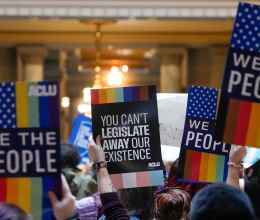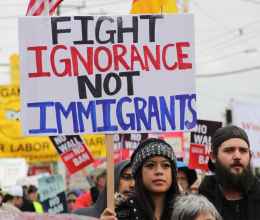
When the ACLU filed Ms. L v. ICE exactly two years ago, it was clear what was going on at the border was shocking and unprecedented: A Congolese mother and her six-year-old daughter had been torn apart by Immigration and Customs Enforcement for seemingly no reason at all. ICE sent them to detention sites thousands of miles away from one another, where for four months they had hardly any contact and didn’t know whether they’d ever see each other again. It was an act of senseless cruelty — a seemingly exceptional case that later turned out to not be so unusual after all.
What ICE did to Ms. L and her daughter was hard enough to grasp on its own, but it was just the tip of the iceberg. There were thousands of Ms. Ls in detention sites across the country, separated from their children with no explanation, and what happened wasn’t a random act of cruelty but part of the Trump administration’s “zero tolerance” immigration policy.
After months of litigation and a court order to stop the official practice, the Trump administration admitted that it had separated more than 2,700 children from their parents. But they didn’t tell the whole story. What they left out were the children they separated who had already left government custody at the time of the court’s order. When the judge demanded the full picture, the government disclosed an additional 1,556 children separated since 2017. In all, that means the Trump administration separated over 4,200 children from their parents.
The ACLU has managed to reunite over 2,000 families since the injunction in 2018. But the fight to stop separations and reunite families continues. The administration is using loopholes to continue separating some families with excuses including dirty diapers, expired driver’s licenses, and other minor offenses that would never justify separation under any U.S. child welfare laws. Today, the ACLU is fighting to stop these separations and locate every last family that remains separated.
How ICE and CBP used fear and misinformation to deport parents
ICE and CBP showed no mercy when they separated children from their parents. Border agents took one young boy with a vision impairment from his parents without letting him take his glasses case, which he needed to protect the glasses his family had saved up to afford. Several other separated kids had disabilities, including a deaf girl taken from her father.
After separation, border authorities used a pattern of fear and misinformation to deport parents without their children. They often told parents they had no right to asylum and that they had two options: get deported with their child, or alone. Ultimately, hundreds of parents were deported without their children.
Some parents knowingly chose to leave their children in the U.S., believing it was the child’s only chance to get asylum and protect them from the danger they originally fled in their home countries. These parents were forced into making an unbearable decision between protecting their child and staying together.
Many parents were deported without understanding what they had agreed to, forced into signing papers in a language they couldn’t read. At times ICE and CBP agents told parents that their child would be waiting for them on the plane. When two parents learned that this was a lie — that their children would not be coming with them — officials had to physically force them onto the plane.
One mother, Belen, fled to the U.S. in fear for her life, only to have her son taken away as soon as she arrived at the border. A survivor of sexual abuse, Belen pursued asylum after passing a credible fear hearing. Border officials later threatened her by telling her that pursuing asylum would only prolong separation from her son, so she abandoned her case. In the end, Belen returned to the country she fled, even though she had a strong case for asylum as an abuse survivor.
Tracking down untracked parents in Central America
The reckless way that ICE and CBP deported parents makes reunification difficult and in some cases nearly impossible. Border authorities deported hundreds of parents, and in many cases didn’t bother to keep any meaningful contact information, like a proper address or working phone number. In 2018, when a federal judge ordered the government to reunite all the families, the administration tried to shift the responsibility onto the ACLU instead.
Reuniting these families is of course the responsibility of the people who separated them. But the Trump administration wasn’t acting fast enough, and the families were understandably reluctant to trust them again. That summer, the ACLU formed a steering committee to locate and help parents, along with partners at Kids in Need of Defense, the Women’s Refugee Commission, Justice in Motion, and the law firm Paul, Weiss, Rifkind, Wharton & Garrison LLP.
One of the reunited families was that of Ricardo and Luna, a father and daughter from Guatemala who were separated near McAllen, Texas in December 2017. Border officials sent three-year-old Luna to a Texas shelter and deported Ricardo, tricking him into believing she would soon join him. But Ricardo returned to Guatemala City with just a sheet of paper containing his daughter’s alien registration number. He was given a toll-free phone number to call for information about Luna, but each time he called, the operators told him they had no record of her in the system.
“When I saw her, I felt my soul ache. She was skinny and sad for all the time she hadn’t seen us. It was a sad but at the same time very joyful moment.” — Ricardo
Luna was part of the class of children under age five prioritized by the court order for reunification. But it wasn’t until a month after the reunification deadline that she was finally returned to her father. By then, the length of her detention was among the longest of any child affected by family separation.
Seeking damages for lifelong trauma
After months of separation, Ever Reyes-Mejia was reunited with his three-year-old son, Sammy. But Sammy seemed to have trouble recognizing his parents. Their difficult reunion was captured on video, showing us how separation causes trauma that reunification alone can’t fix.
The trauma of separation will cause lifelong trauma for whole families, but children under the age of five, like Sammy, will feel the effects the most. To hold the Trump administration accountable, the ACLU filed another lawsuit last year seeking damages for these families, as well as the creation of a fund to pay for professional mental health services.
At shelters in the U.S., children have been hospitalized for behavioral health issues that arose during detention, including suicide attempts. And like Sammy, children are showing signs of trauma even after reunification. One young boy would cry whenever his father left the room because he thought he was going to be abandoned again.
Parents also face an increased risk of developing mental health disorders. Belen was described by a former asylum officer as “one of the most traumatized and vulnerable persons that I have ever interviewed.” During her separation from her son, she was in such distress that part of her face would become paralyzed for days at a time. She has since been reunited with her son, but due to the trauma of separation, she won’t leave her house unaccompanied.
Detention itself is traumatic. Ricardo’s daughter Luna was held in a shelter plagued by sexual abuse allegations, and there is a well-documented history of CBP abusing children in its custody. Facilities are often overcrowded, with scarce food and water and no way to bathe or brush teeth. At several shelters, parents staged hunger strikes to protest the refusal of ICE and CBP officials to provide any information about their children.
“I did not know what was happening and I had no idea where my son was.” — Eduardo
These traumas will stay with families for a lifetime, and it’s the Trump administration’s fault. A July 2019 House Oversight staff report concluded that those responsible have “not been candid with the American people” about the horrors families faced, and that the separations were “more harmful, traumatic, and chaotic than previously known.”
Where we stand two years after Ms. L
Ms. L and her daughter had traveled across ten countries and three continents seeking safety here, only to be traumatized with separation. Her daughter had to spend her seventh birthday in a detention cell, alone, not knowing whether she’d ever see her mother again. But they were among the fortunate ones: soon after the lawsuit filed on their behalf, Ms. L and her daughter were reunited.
Family separation is just one of the ways the Trump administration has deliberately tried to stop people from seeking asylum here. The administration has also tried to gut asylum protections for immigrants fleeing domestic violence and gang brutality, ban people from applying for asylum outside of formal ports of entry, force asylum seekers into Mexico to await far-off court dates in the U.S., and bar asylum seekers who have passed through other countries without first applying for asylum in those countries. Poor infrastructure and instability in many countries in the region makes it incredibly difficult to live in safety, let alone go through the asylum process. The administration is trying to make the asylum process so torturous that people will continue to live in danger rather than seek safety.
Denying protection for people fleeing danger is a violation of the law and basic human rights. The U.S. government must treat them with humanity and uphold their right to seek asylum.
NOTE: All names have been changed to protect identity and safety.
Leila Rafei, Content Strategist, ACLU


